Damodar River, West Bengal
Damodar River was earlier known as the Sorrow of Bengal as it used to flood many areas of Bardhaman, Hughli, Howrah and Medinipur Districts. Even now the floods sometimes affect the lower Damodar Valley but the havoc it wreaked in earlier years is now a matter of history.
In 1789 an agreement was signed between Maharaja Kirti Chand of Burdwan and the East India Company wherein the Maharaja was asked to pay an additional amount of Rs. 1,93,721 for the construction and maintenance of embankment to prevent floods. However, these ran into a dispute and in 1866 and 1873, The Bengal Embankment Act was passed, transferring the powers to build and maintain embankemnt to the government.
The Damodar Valley is spread across Hazaribagh, Koderma, Giridih, Dhanbad, Bokaro and Chatra districts in Jharkhand and Bardhaman and Hughli districts in West Bengal and partially covers Palamau, Ranchi, Lohardaga and Dumka in Jharkhand and Howrah, Bankura and Purulia in West Bengal with a command area of 24,235 sq km.
The Damodar Valley contains large reserves of coal and mica, and the area is a highly developed industrial belt. Many refer to the Damodar Valley as the Ruhr of India because of its similarities with the Ruhr mining-industrial area of Germany. The dams on the Damodar River have several hydroelectric power plants. Of late, the Damodar has become one of the most polluted rivers of India, with chemicals, mine rejects and toxic effluents flowing into the river from mines and industries located in the valley. Efforts are being made to reduce the level of pollution in the river.



0 Comments:
Post a Comment
<< Home